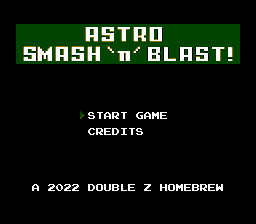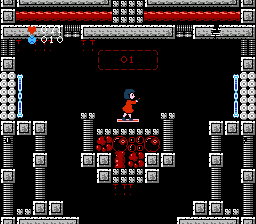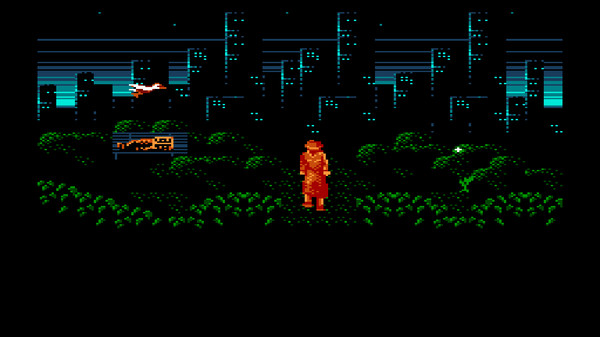
On Romhack Thursdays, we bring you interesting finds from the world of game modifications.
Most of the things we post here are game hacks. That is, something that has been modified from a published game. Hacking games is not illegal, but the process that some people usually use to obtain the roms themselves may be somewhat questionable. Well not for the subject of this week’s article: it’s 100% homebrew, created from scratch and unencumbered by such considerations! It runs on NES hardware (or an NES emulator), but technically speaking what we have here is more of an indie game on classic console hardware more than a hack.

It’s also an unusual subject for a 2022 indie game. You’ll find all kinds of hacks to, say, put silly characters into Super Mario Bros., but a remake of an Intellivision game, and one with an Atari port that is very much its equal, and porting those games to the NES-that’s unusual enough to merit discussion, even if the game itself is very simple.
Astrosmash! (with the exclamation point) was a very popular game for the Intellivision. I heard it was originally intended to be an Asteroids-style game, with rocks that split into pieces when shot, but turned out to be interesting translated to a Space Invaders-style missile base game, where your ship is stuck to the bottom of the screen shooting at targets falling from above. Astroblast! was released by M-Network (Mattel’s label for publishing games for competing systems), and was a very similar game for the Atari VCS/2600, but actually improved on the original in two ways: it can be played with either the joystick or paddle controller. It’s the only game for the VCS like that! Both control schemes are fun, although experts can probably play much better with the paddle, due to both its faster and more precise movement. And, it’s extremely fast! The sheer pace of the VCS Astroblast is so much greater than the Intellivision Astrosmash that it kind of demonstrates why VCS games tend to be more engaging than Intellivision games: it wastes no time with an easy ramp up in difficulty, but starts faster than almost any other game, and only gets harder from there. It’s simply exhilarating!

The way it works is like this. Rocks, Pulsars and Spinners fall from the sky, and your ship tries to shoot them before they hit the ground. You get points for shooting things, but lose points for things that get past you. Rocks come in two sizes (smaller ones have higher point values), but only kill you if they hit you. Big rocks break apart into small rocks when stuck. Pulsars home in on you as they fall, which makes it more likely they’ll hit you, but also means they’re easier to shoot. The most dangerous items plummeting towards you though, by far, are the Spinners. You must shoot Spinners, you don’t just lose points if one lands but a life. Small Spinners are your greatest enemy, since they’re also hard to hit. There’s also UFOs that harass you, which pass by horizontally and drop bombs on you.
Here is a short game of Astroblast, to give you a sense of how it works. Notice how fast it is. Know that this is nowhere near as fast as it gets. It is my kind of game:
As you score gets higher, the background color changes, and the game gets faster. You get extra lives every 1,000 points, and you start with ten, far more generous than most arcade-style skill tests from that time, but you need all those lives because you’re constantly dying. Difficulty is determined by score, the more points you have the faster it gets. Because you lose points as well as gain them, and because the speed is balanced right at the edge of human reaction time, players tend to play until they reach a difficulty score boundary, where only nearly-inhuman focus, and lots of practice, can push you beyond it. Astroblast will push your playing skills to the very limits.

Astro Smash ‘N’ Blast is an homage to these two games. It takes the same form, your ship at the bottom shoots upwards at an endless wave of plummeting targets, Rocks, Pulsars and Spinners. (There are no UFOs in this version.) There’s fewer things falling, but the game is a bit more precise about hitting small targets. Pressing the Select button turns on autofire, which you’ll probably want to use, to avoid compressing your thumb tissue into a singularity with rapid frantic tapping.
Rocks don’t split in two in this version, but otherwise it plays a lot like VCS Astroblast. Small Spinners are particularly difficult targets to hit, and must be aimed at precisely.

This version takes on a bit of inspiration from Pac-Man CE, in that in addition to having limited lives, you have a time limit. You can earn extra time by hitting +30 second targets that pass by horizontally, and you can regain hits on your ship by hitting passing 1UPs. These are the only bonuses; unlike the originals, you don’t get extra ships from points at all. Although the game ends if you run out of time, chances are great that you’re going to lose all five of your lives before then.
As in Astrosmash/blast, as you ascend to tougher difficulties, the screen’s background color changes. You probably won’t see the later levels though without a lot of practice. Astro Smash ‘N’ Blast offers a level of challenge rarely seen in most games. I prefer games like this, with a strong element of chaos, to more typical modern examples of high challenge, like bullet hell shooters and rhythm games. I think the essence of the super fast video game is in randomness, not memorizing levels and playing them almost by rote but in reacting instantly to dynamic situations, and that’s why I like all the Astro-style games.

I am left wondering what inspired Double Z to look to old Intellivision and Atari games for inspiration. They were released when I was a small child; had Double Z even been born yet when the Astro games were on store shelves? For whatever reason they made it, I am glad they did. Games like this don’t come around often any more, and I intend to put in some solid practice on it.
Astro Smash ‘N’ Blast, for NES (romhacking.net)


























